Are you considering secular homeschooling? Are you a secular homeschooler looking for curriculum? This list of resources was compiled with you in mind. I myself am a secular homeschool teacher (focusing on science, history, and culture) and have used most or all of these resources. I use many of them on an ongoing basis.
There are many ways to think about secular homeschooling. For some, it means presenting a religion-neutral curriculum that reflects national or local public school standards. For others, it could mean emphasizing secular traditions. Still others may choose to highlight where there are differences between secular and religious traditions. Either way, finding non-religious homeschool materials can be challenging due to the seemingly large portion of materials developed for religious homeschoolers.
I’m the dad of two energetic elementary-school kids, and our homeschooling has us out and about frequently. We enjoy field trips and hands-on opportunities, and quite often some aspect of our family travels are focused on learning opportunities. You’ll see this flavor reflected in the list of resources below.
Books and other Media
1. Usborne Encyclopedia of Geography
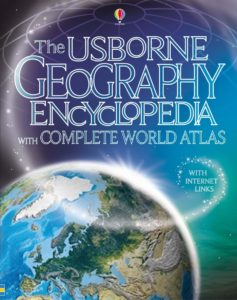 This is a fantastic geography text designed for kids in grades 4-6. It starts with the Big Bang and talks about geography in that context. There are lots of pictures, and it’s all presented in bite-sized chunks of two pages or so per topic. The first half of the book is focused on physical geography. The second part focuses on social geography, what I think of as social or cultural studies. It has links to web resources. We’ve worked our way through this book slowly by taking turns reading. I’ve also developed worksheets to help reinforce the learning.
This is a fantastic geography text designed for kids in grades 4-6. It starts with the Big Bang and talks about geography in that context. There are lots of pictures, and it’s all presented in bite-sized chunks of two pages or so per topic. The first half of the book is focused on physical geography. The second part focuses on social geography, what I think of as social or cultural studies. It has links to web resources. We’ve worked our way through this book slowly by taking turns reading. I’ve also developed worksheets to help reinforce the learning.
2. Usborne Encyclopedia of World History
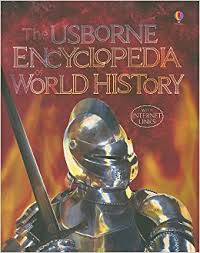 Here’s another fantastic book from Usborne with a similar age focus (grades 3-6). We’re making our way slowly through this text as well, as we’re doing with the Usborne Encyclopedia of Geography.
Here’s another fantastic book from Usborne with a similar age focus (grades 3-6). We’re making our way slowly through this text as well, as we’re doing with the Usborne Encyclopedia of Geography.
3. In the Beginning: Creation Stories from Around the World
 This one includes the Genesis story, along with creation stories from Greek, Mayan, Minyong, Egyptian, Marshallese, Tahitian, Babylonian, Nigerian, Icelandic, Zambian, Huron, Krachi, Northern Aranda Aborigine, and Chinese cultures, among others. What I like about this text is that it presents the narratives as cultural myths and not as fact. I also like that it exposes kids to a variety of origin stories. We’ve had fun talking about similarities and differences among the myths. It targets higher grade levels (ages 12 and up) , but my kids love stories, and enjoyed this as early as ages 7 and 8. We’ve come back to this book again and again as we encounter references to origin myths in our other studies.
This one includes the Genesis story, along with creation stories from Greek, Mayan, Minyong, Egyptian, Marshallese, Tahitian, Babylonian, Nigerian, Icelandic, Zambian, Huron, Krachi, Northern Aranda Aborigine, and Chinese cultures, among others. What I like about this text is that it presents the narratives as cultural myths and not as fact. I also like that it exposes kids to a variety of origin stories. We’ve had fun talking about similarities and differences among the myths. It targets higher grade levels (ages 12 and up) , but my kids love stories, and enjoyed this as early as ages 7 and 8. We’ve come back to this book again and again as we encounter references to origin myths in our other studies.
4. Richard Dawkins: The Magic of Reality
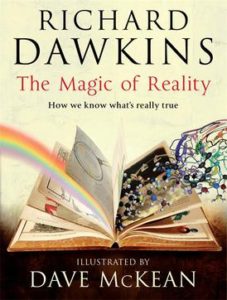 This is available as a book, but we used the interactive and engaging iPad download. It discusses a range of natural phenomena from a simplified scientific point of view, and contrasts what we know now with what pre-science cultures thought. Each chapter addresses a single question. Some examples: How old is the universe? What causes tsunamis? Why are their so many kinds of plants and animals?
This is available as a book, but we used the interactive and engaging iPad download. It discusses a range of natural phenomena from a simplified scientific point of view, and contrasts what we know now with what pre-science cultures thought. Each chapter addresses a single question. Some examples: How old is the universe? What causes tsunamis? Why are their so many kinds of plants and animals?
5. Crash Course Mythology
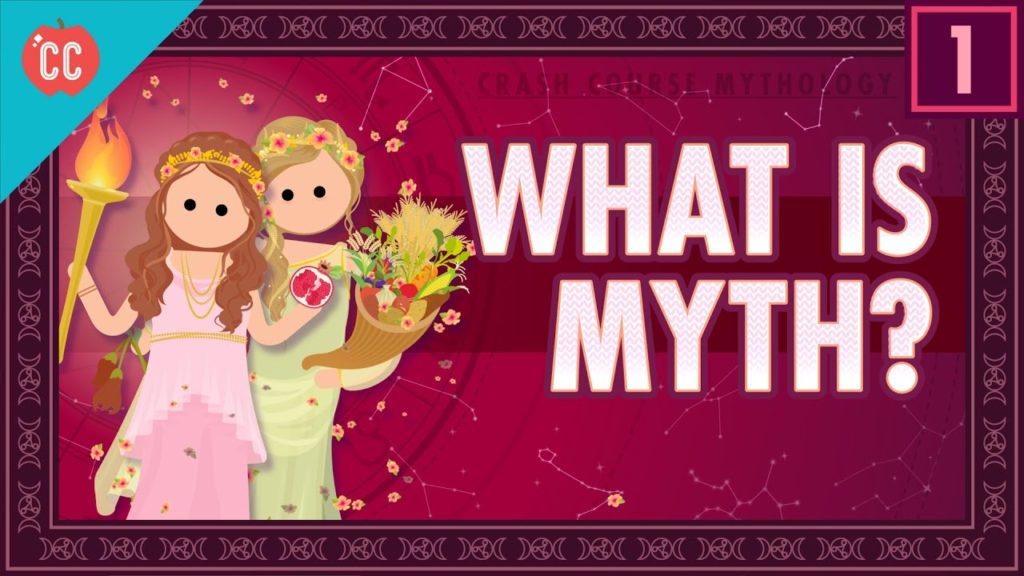
There are 40+ ten-minute videos in this series. I made a course out of the first 20. Even in this abbreviated form, kids are getting a solid introduction to world mythology. The first 20 videos cover pantheons, creation myths, hero myths, flood myths, and more, from a variety of ancient cultures. I supplemented the series with worksheets, readings, and assignments that included asking the kids to create their own pantheons and then having them develop short stories and draw comics around their characters.
6. Sapiens: A Brief History of Humankind (Video Series)
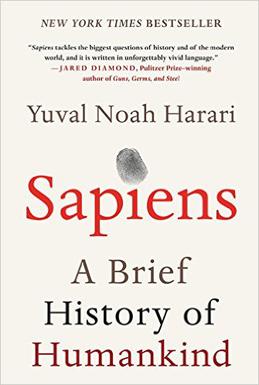
My older one and I enjoyed Yuval Noah Harari’s lecture series, which is the basis for his book of the same title. The video referenced here is one of his summary lectures; individual detailed lectures are also available on YouTube. I was looking for a resource that would be easier for my son to digest than the book, which I’d read already. The lectures are presented in fairly dry fashion, but the material is fascinating. It explores such topics as the origin of language, origins of technologies, the agricultural revolution, the emergence of villages, towns, and cities, the evolution of the human brain, and more.
7. What Your Fifth Grader Needs to Know
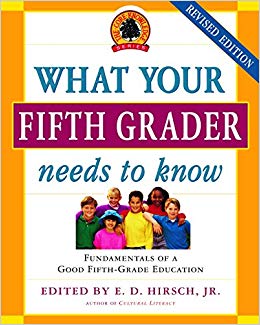
This title is an example of the series. I use these books from time to time to make sure I’m covering roughly the material my kids would see in a typical grade setting, but I’m not too strict about it. Once in a while, we’ll read directly from the text (which consists largely of condensed accounts, narratives, and descriptions) where it seems like we need to fill in the gaps.
Activities
8. UNESCO World Heritage Sites
These sites of historical, cultural, and scientific interest are the cream of the crop. If you have a chance to visit, don’t hesitate. So far, we’ve hit about half the ones in North America. Some of our favorites include Mistaken Point Ecological Reserve (Newfoundland, Canada), Head-Smashed-In Buffalo Jump (Alberta, Canada), and Glacier National Park. You may have visited some of these sites already; the sites in the U.S. typically don’t announce that they’re UNESCO World Heritage Sites at all.
9. Your Local Secular College or University
If you live near a college or university, you may be able to take advantage of public lectures, presentations, and activities. Many universities, such as the University of Colorado, even have programs specifically for homeschoolers. We’ve taken advantage of these kinds of programs at the University of Pennsylvania Museum and University of Wyoming. Keep an eye out for opportunities that might not immediately look like something for your homeschooler. For example, we’re attending public presentations at University of Wyoming’s planetarium, where they host a Summer Astronomy Challenge for kids. I’ve designed a homeschool astronomy syllabus around it.
10. Homeschool Programs at Your Local Zoo, Aquarium, or Science Center
Zoos, aquariums, and other science centers often have open programs and even sessions specifically for homeschoolers. I’ve got my eye on a homeschool program at the Monterey Bay Aquarium.
Here are some more examples.
Oklahoma City Zoo Homeschool Program
Memphis Zoo Homeschool Program
11. Local Field Trips
Here’s your chance to be creative. We try to do several local field trips per month. Sometimes it’s as many as one per week. It takes time to scan Facebook, local media, and library listings for events and programs. Sometimes there are programs specifically for homeschoolers. Our favorites usually center on museums, historical sites, and geological sites. Sometimes there’s no one to host; you have to make your own way, as we did when we visited the stromatolite fossil beds on Libby Flats in the Snowy Range of southeastern Wyoming.
Online Resources
12. Facebook
Facebook is a great place to connect with other secular homeschoolers. We’ve been part of a number of local secular homeschool groups on Facebook. Some are more active than others There are also national and global groups as well. Here are links to some general groups focusing on secular homeschooling.
Secular, Eclectic, Academic (SEA) Homeschoolers
Secular Homeschool Families (Public Group)
Secular Homeschool Families (Closed Group)
13. Websites & Articles
There are a few websites catering to secular homeschoolers. I’ve listed a few below.
http://www.secularhomeschool.com/content/
https://upabovetherowantree.com/ultimate-guide-secular-homeschoolers-curriculum/
https://www.theatlantic.com/education/archive/2016/03/homeschooling-without-god/475953/
